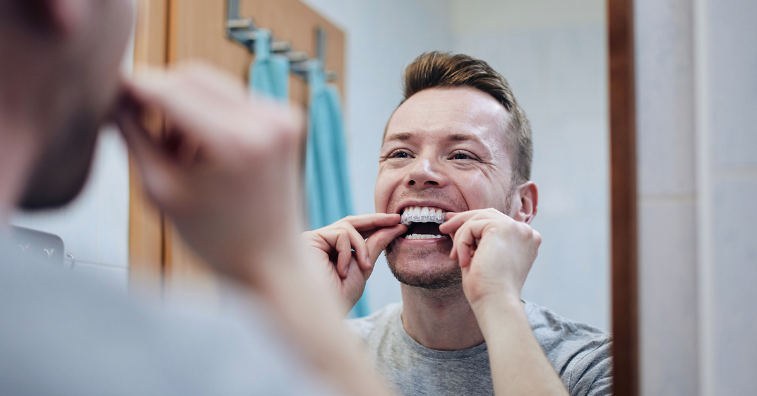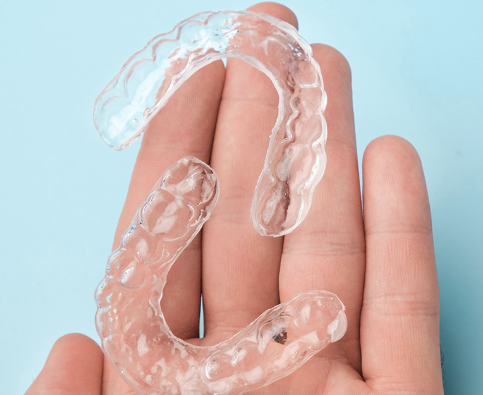When it comes to straightening misaligned teeth, adults typically think of braces as the clunky, obvious, awkward versions we grew up with. However, as technology has advanced, so have our methods of fixing misalignments. Today’s braces are not only much more unobtrusive than in years past, but there are even types that are completely invisible when in place. Among these relatively invisible options are orthodontic aligners that shift the teeth into place without the need for brackets, bands, and wires.
This is where Invisalign comes in. This popular style of aligner not only addresses many of the problems people had with the old style of braces, it also warrants consideration by anyone who needs to address misaligned teeth. Better yet, Invisalign has benefits not provided by other forms of orthodontic appliances. Learn more about Invisalign, how the system works, and why it might be right for you.
What Is Invisalign?
Invisalign aligners were created in California in the late 1990s. The creators would soon become known as Align Technologies, and they had the primary goal of helping adults achieve straighter teeth discreetly without the need for obvious braces or painful dental procedures. Their version of the invisible retainer was the first Invisalign system, and once they introduced the product to the American markets, the idea spread across the dental appliance market. So, what is an Invisalign aligner system, and how can it help people achieve straighter teeth without the need to attach to the teeth?
An Invisalign aligner is made of a clear, flexible plastic that’s non-toxic, making it completely safe to wear long term. Over time, the patient will wear a series of aligners, each designed incrementally differently, to slowly shift the teeth into place. The primary purpose of the Invisalign creators was to create a system as invisible as the name implies—and they were successful, as Invisalign is essentially undetectable while in place. Adults and teens can wear Invisalign aligners without drawing attention to their teeth.
 What Are The Advantages of Invisalign?
What Are The Advantages of Invisalign?
Invisalign aligners have multiple advantages besides their relatively invisible nature. These benefits are unique to their design, and for many people, they are better than traditional orthodontic methods in some aspects. Here are the main advantages of Invisalign.
Invisalign Works Just As Well As Braces In Most Cases
Invisalign aligners are designed to address many of the same problems other braces address. Invisalign can help to fix crowded teeth, gaps, underbites, and overbites. It’s worth noting that severe issues are not as easily fixed with Invisalign, and you may need to use traditional braces for a time, first. Invisalign is also suited for adults and teens rather than for children. Under the right circumstances, however, an Invisalign aligner is all you need to repair and straighten teeth, no braces required!
Invisalign Is Designed to Be Comfortable
The Invisalign system isn’t the first discreet orthodontic method invented. For example, lingual braces have been around even longer than invisible aligners and they’re also designed as invisible orthodontic equipment. However, lingual braces are still braces, and they’re different because the brackets are affixed to the inner surfaces of the teeth. They are generally a bit more restrictive than traditional braces, and less comfortable to wear since they are closer to the surface of the tongue. They also make use of wires that, if broken, may injure the interior of the mouth. Invisalign, meanwhile, fits over your teeth and are designed to be comfortable. Eventually, most users report not noticing they’re wearing Invisalign at all.
Invisalign Is Removable and Convenient to Use
One of the biggest hassles associated with braces is the fact that they’re attached to your teeth permanently until the straightening process is finished. At this point, another orthodontic appointment is necessary to remove the braces. For some people, this is inconvenient. Braces also restrict what you can eat, how you floss, how you brush, and more. If users don‘t practice excellent oral hygiene while wearing braces, cavities and other forms of tooth decay may be more likely.
By contrast, Invisalign is removable, which means you don’t have to worry about the “right way” to eat or care for your teeth. Just live as you normally would and remove the aligner when you need to eat, brush, and floss. Switching to the next Invisalign aligner is as simple as taking the current aligner out and replacing it with the new one.
Shorter Treatment Time
Braces can take months, if not years, to fix your smile. They also require frequent appointments to install, change, and remove. Invisalign doesn’t have either issue. In most cases, patients receive multiple aligners at once, with minimal refinement aligners along the way, so you will likely not require multiple visits to finish treatment. Invisalign can take less than half the time to straighten teeth as traditional braces, depending on the severity of the misalignment.
Invisalign Can Keep Your Teeth Cleaner and Safer
An Invisalign aligner covers your teeth for several hours a day, which protects them from damage teeth are commonly exposed to. While the aligner itself can develop buildup over a day’s use, it can be washed and replaced as necessary. In addition, injuries that could cause oral trauma, like a bad fall, may be less severe when Invisalign is in place. Invisalign also places a barrier between your teeth and the bacteria we naturally encounter while eating and drinking. There are even Invisalign products that can help to keep your teeth white while they become straighter.
Invisalign Produces Predictable Results
Invisalign aligners are called “aligners” for a reason. They have the ability to realign your teeth and make changes according to the alignment plan your orthodontist created ahead of time. The results can be easily predicted when using Invisalign products, as they allow orthodontists to have more control over what happens to your teeth.
Invisalign FAQs

Now that you know more about how Invisalign works and have browsed the advantages of Invisalign, it’s time to dive deeper into this orthodontic marvel.
Here are some common Invisalign questions.
Q: Is It Worth It to Get Invisalign?
A: Invisalign is usually worth investigating for most orthodontic patients. It might be clear by now that an Invisalign aligner can be just as useful as traditional orthodontic equipment, if not better. From keeping your teeth straight to their added convenience, comfort, and discreet style, there seems to be little reason to decide against Invisalign, especially if your misalignment isn’t severe.
Q: How Much Does Invisalign Cost?
A: The cost of treatment with Invisalign aligners depends on many outside factors. These can include how many refinement aligners you require, how long straightening will take, whether or not you have dental insurance, and more. Typically, Invisalign is comparable to or less than the cost of braces. Ask your orthodontist about getting the treatment you need at a price you can afford.
Q: What If Invisalign Aligners Break?
A: It’s true that Invisalign aligners aren’t as strong as traditional, metal wire braces. While both systems can break, the fact that an Invisalign is made of plastic might make it seem like it is less sturdy. However, Invisalign aligners can be replaced easily—in fact, even traditional retainers must be replaced periodically. You’ll also need to swap out your aligners as your straightening progresses.
Q: Do I Have To Wear Invisalign Permanently?
No. The length of your Invisalign treatment will depend on how much work needs to be done to align your teeth. Plan on at least 12 hours per day for six to twelve months. Then, when the treatment ends, you don’t need to keep wearing them all day, every day. Most users will continue wearing a retainer at night a few days per week indefinitely.
With Invisalign, the Choice Is Clear
If you’re visiting the orthodontist to achieve a straighter, healthier smile, it’s important to explore the various options available to realign your teeth. For many people, it might seem like orthodontics begins and ends with braces, especially if you’ve already had to go through this process as a child. This is no longer true, thanks to modern advances in orthodontic technology. Invisalign is a braces-free way to correct misalignments, and is often the preferred option for orthodontists and patients alike.
Remember—it’s not always possible to use Invisalign in place of braces. The right straightening technology for you will depend on many factors, including your age, the severity and type of the alignment issue, the opinion of your orthodontist, and more. To learn whether Invisalign is right in your unique situation, it’s important to discuss the various options with your orthodontist after a thorough examination.
Invisalign Technology Is Available at Robison Orthodontics

Of course, if you have misaligned teeth, you have a number of options for fixing them. More adults than ever before are choosing to address crooked or overlapping teeth, and it is perfectly acceptable these days to be seen wearing braces. However, while braces are, as mentioned, much more low-profile and comfortable to wear than in the past, Invisalign enables more people to seek orthodontic help even if they’re self-conscious about wearing braces. Better accessibility of teeth straightening services was, in the end, the primary goal of the Invisalign creators, and it continues to be effective today.
*Editor’s Note: This article was originally published Dec 16, 2020 and has bee updated October 21, 2022.

Dr. Tyler Robison is an alum of Mesa’s Mountain View High School. He graduated from Brigham Young University before being accepted to the “Top Ten-nationally ranked” University of Louisville in Kentucky, where he earned his Doctorate in Dental Medicine and a Master’s Degree in Oral Biology. He graduated with honors in the top ten percent of his class. Dr. Robison continued at the University of the Pacific in San Francisco, where he received a second master’s degree in dental science and his orthodontic certification.


